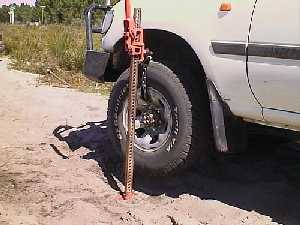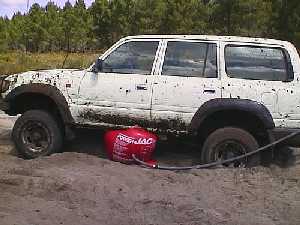
Jacking

CAUTION - Never get under any vehicle that is only supported by a jack.
Hi-lift Jack The best (and only!) jack for four wheel drives is the Hi- lift type. It can
lift virtually any vehicle and, with the aid of chains, it can be used as a winch.
The best (and only!) jack for four wheel drives is the Hi- lift type. It can
lift virtually any vehicle and, with the aid of chains, it can be used as a winch.
The standard jack supplied with most four wheel drives can only raise the vehicle sufficiently to change a tyre on bitumen or hard packed surfaces when the vehicle is not bogged. They usually rely on placing the jack under the vehicle in special slots. Try doing this when you are bogged to the chassis in sand or mud! The Hi-lift type can be used on any suitable part of the vehicle and can lift it for higher than the standard jack.
 Some vehicles do not have suitable points to use a high lift jack due to the
curved nature of their bodies. There are several types of jack adapters available to
overcome this limitation. The adaptor pictured here attaches to the gap in the tyre rim.
It is suitable for most steel rims, but generally does not suit alloy rims. This adaptor
also fits to most bull bars.
Some vehicles do not have suitable points to use a high lift jack due to the
curved nature of their bodies. There are several types of jack adapters available to
overcome this limitation. The adaptor pictured here attaches to the gap in the tyre rim.
It is suitable for most steel rims, but generally does not suit alloy rims. This adaptor
also fits to most bull bars.
It is best to have a jack plate around 300mm x 300mm when jacking on sand or mud to stop the jack burying itself. 7 ply plywood or 3.5mm steel is ideal, or if you carry a barbecue plate, this may be suitable. To test your jack plate, place 2 bricks 200mm apart with the jack plate on top, Slowly jack the vehicle while observing the plate. If it survives this without distortion it should be suitable.
A Hi-lift can be used as a jack with the aid of suitable chains. The top of the jack is attached with a chain to a suitable anchor point while another length of chain is attached to the bogged vehicle. On the bottom end of the jack is attached a length of chain with a clevis hook, while on the moving leg of the jack is attached a chain with a clevis claw.
This allows the jack to pull the vehicle approximately one metre and then attach the clevis hook while lowering the jack. The clevis hook stops the vehicle from moving back as the jack leg is lowered, ready to move the vehicle one metre again. This process is repeated until the vehicle is free.
Exhaust Bag Jack
 The exhaust powered bag type of jack is
very simple and easy to use, provided it can be placed under part of the vehicle. It is
quite effective, especially in sand where, if necessary, a small area can be dug away to
accommodate it. It requires the vehicles exhaust system to be in good condition as even a
small hole will prevent the bog from inflating. It can also cause rusted or weak areas in
exhaust systems to blow out.
The exhaust powered bag type of jack is
very simple and easy to use, provided it can be placed under part of the vehicle. It is
quite effective, especially in sand where, if necessary, a small area can be dug away to
accommodate it. It requires the vehicles exhaust system to be in good condition as even a
small hole will prevent the bog from inflating. It can also cause rusted or weak areas in
exhaust systems to blow out.
Once in position, connect the pipe to the vehicle
exhaust and start the engine (in neutral). When the wheel is clear stop the engine and
simply fill in the hole or rut with whatever is available or dig away any sand that has
built up.
Recovery
Jacking to recover a vehicle is usually done to get a wheel out of a rut when a vehicle is "hung up", or to fill in wheel holes in dirt and sand. It allows any available material to be placed under the wheels of the bogged vehicle to either provide traction or build up a rut to enable the vehicle to drive out. Furthermore, it can be used to "break suction" in mud when snatching or winching is not working.
Additionally, by jacking up the entire end of a vehicle with the Hi-lift jack, for example on the tongue of the towbar, the vehicle can then be pushed sideways to allow it to be move out of a rut or soft section. This procedure must be performed with no bystanders near the jack in case it springs out.
Jack the vehicle in the middle of either end until both wheels are clear of the ground by at least 300mm.
Clear everyone from the jack end of the vehicle and position yourself with the vehicle between you and the jack so that it cannot spring out and strike you. Be aware of where the jack may end up and ensure it won't contact any part of the vehicle when it moves.
Proceed to push the jacked end until it topples off the jack. This procedure can be repeated at both ends of the vehicle to "walk" it sideways.
This procedure has inherent dangers as the vehicle is very unstable with two wheels off the ground. All bystanders should be well clear of the vehicle and the person operating the jack should be aware that it may "pop out" unexpectedly. (c) 4WD Encounter 1998
These pages were last
updated on 28th October 1998.
Hits since 29th September 1998: